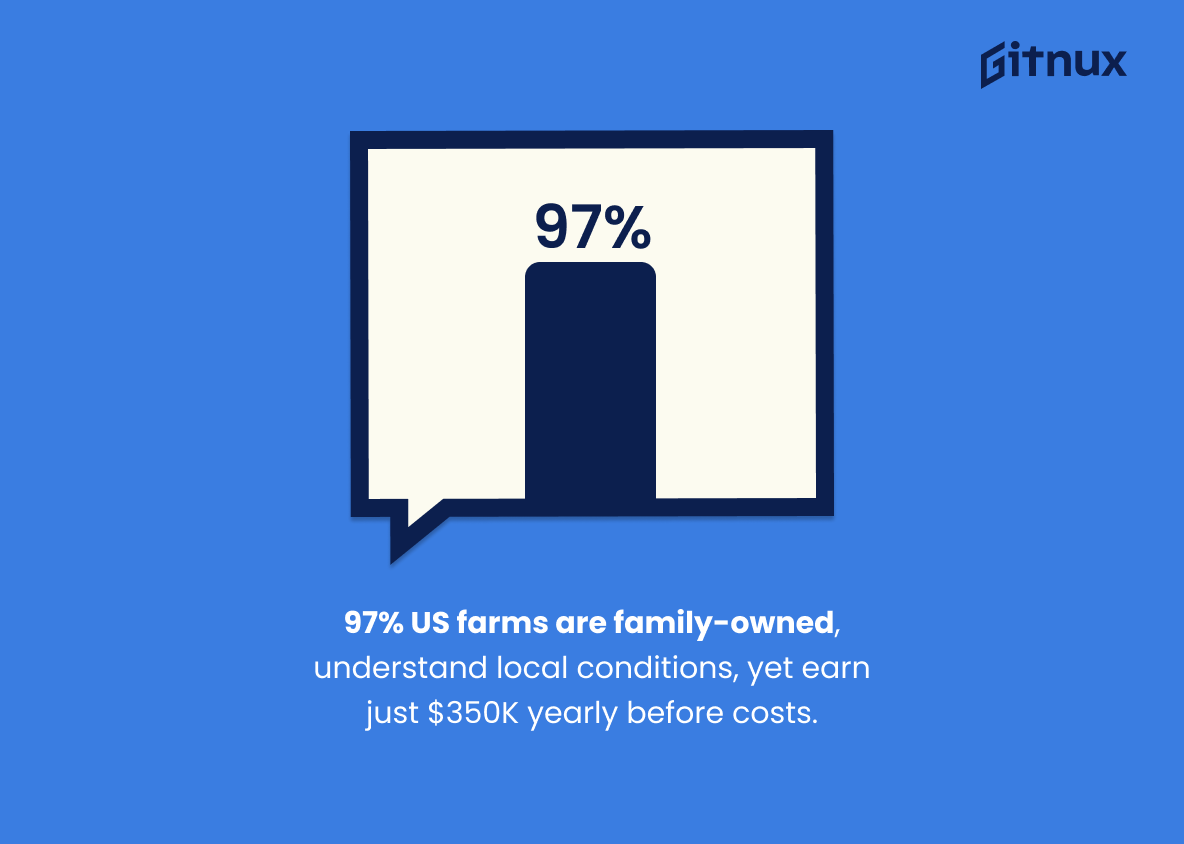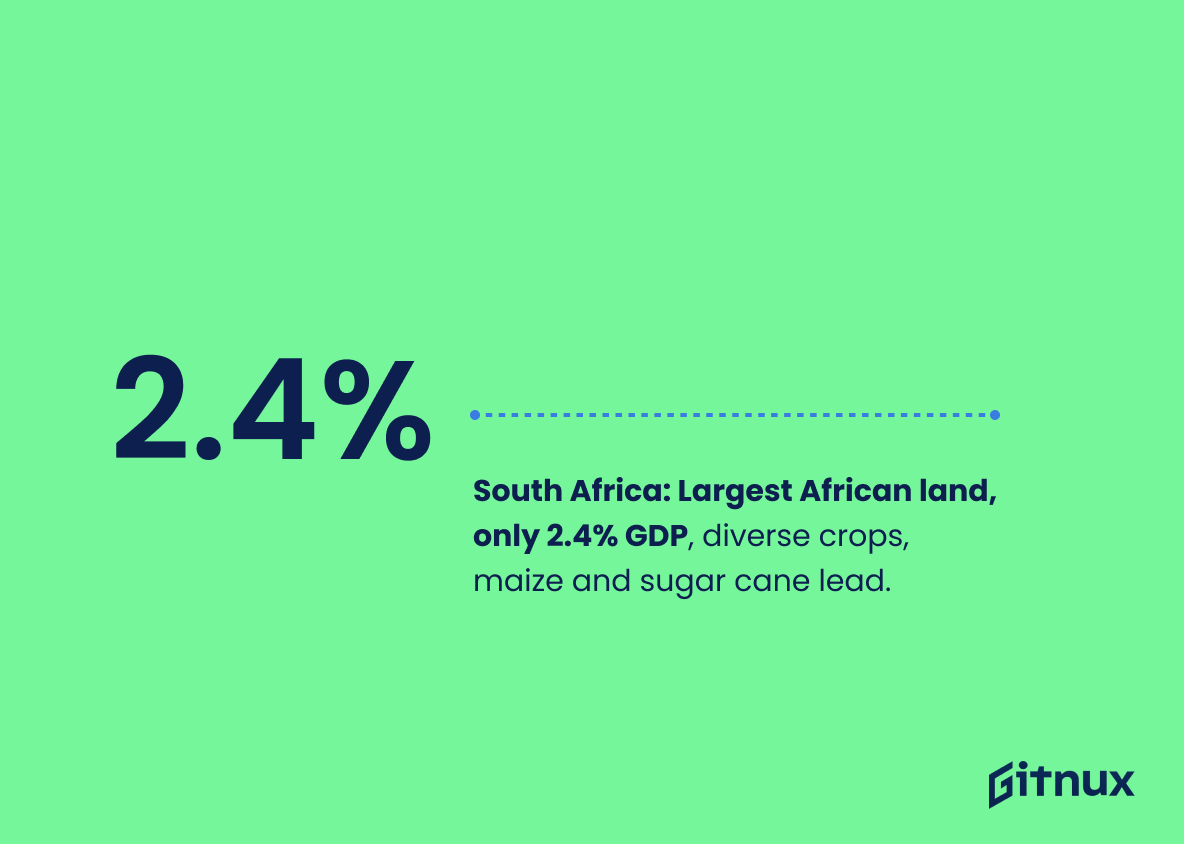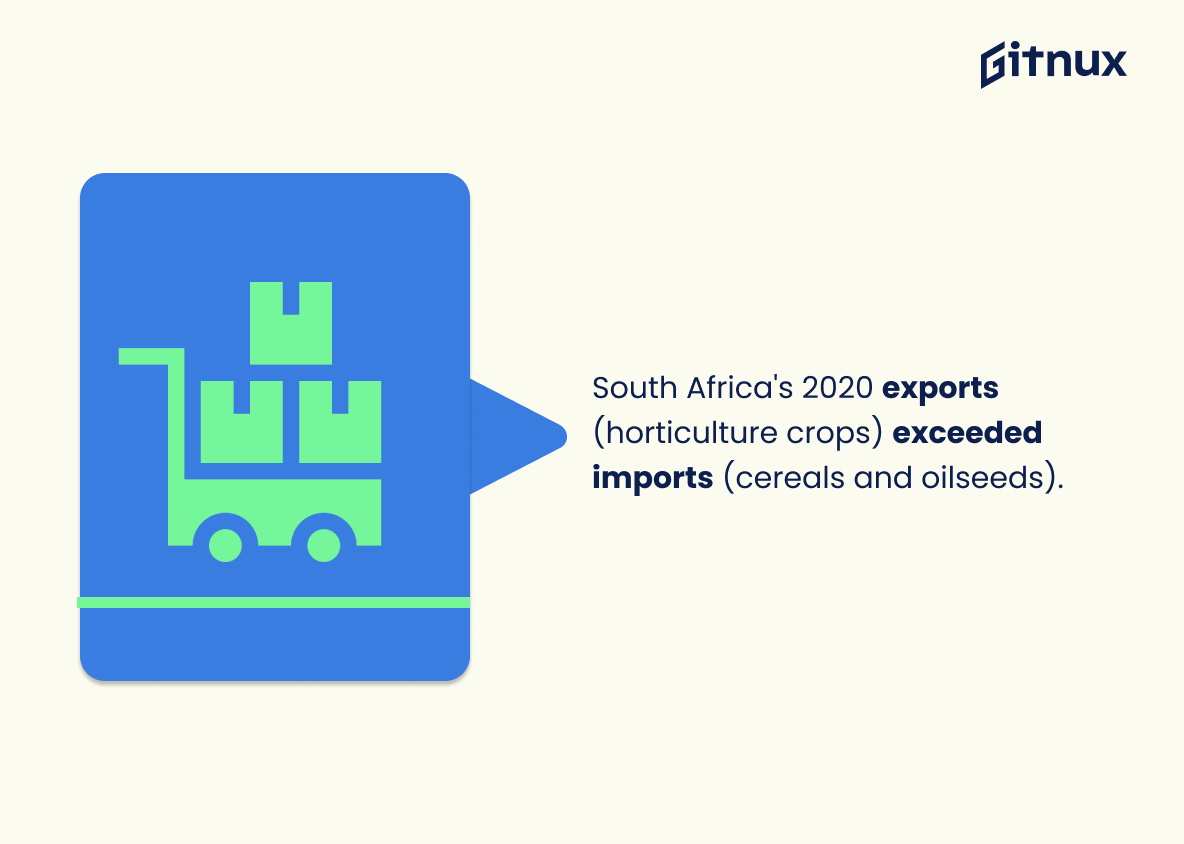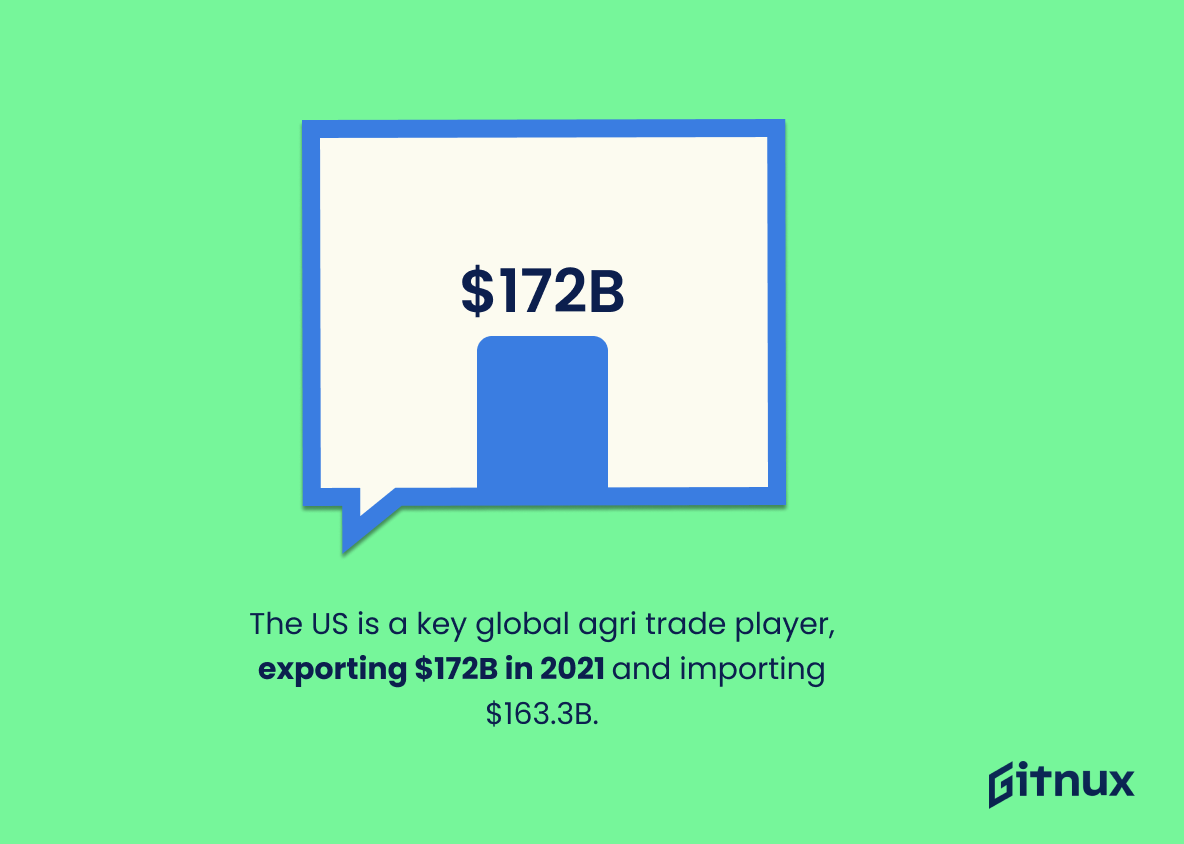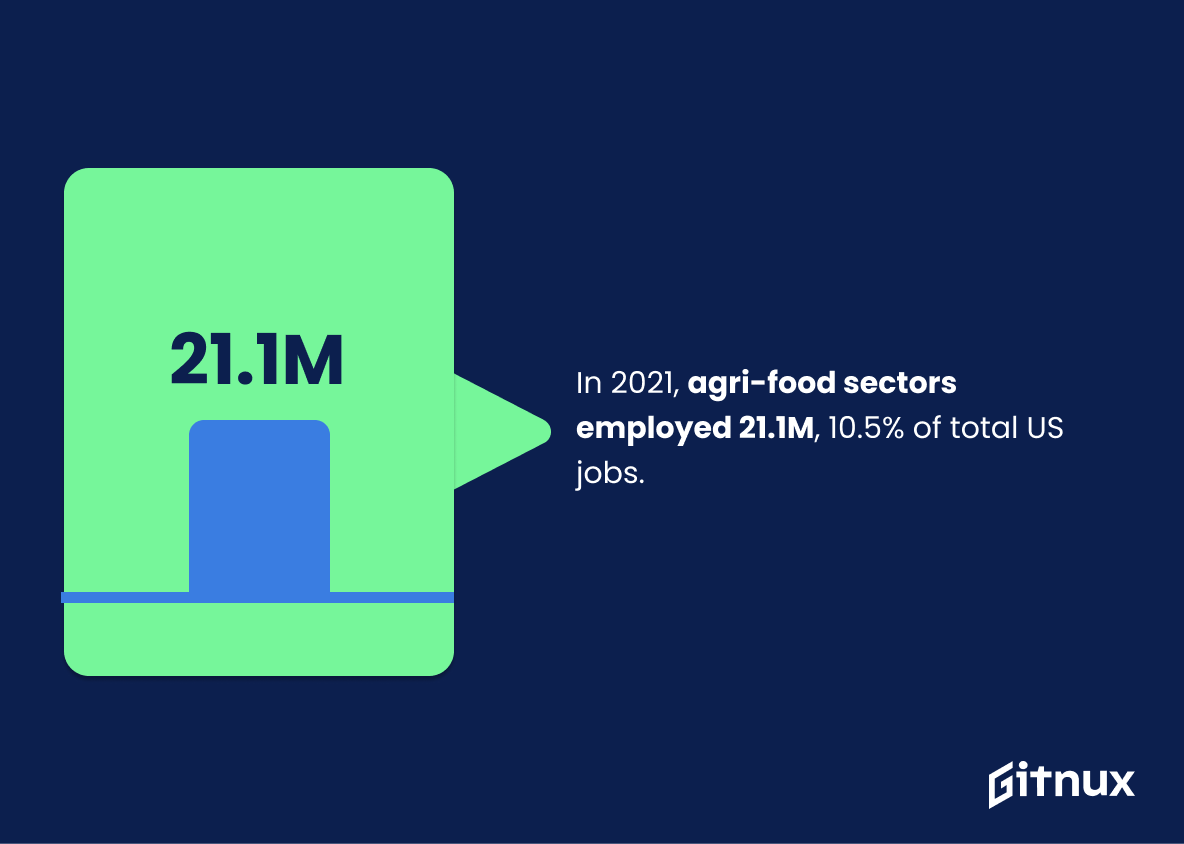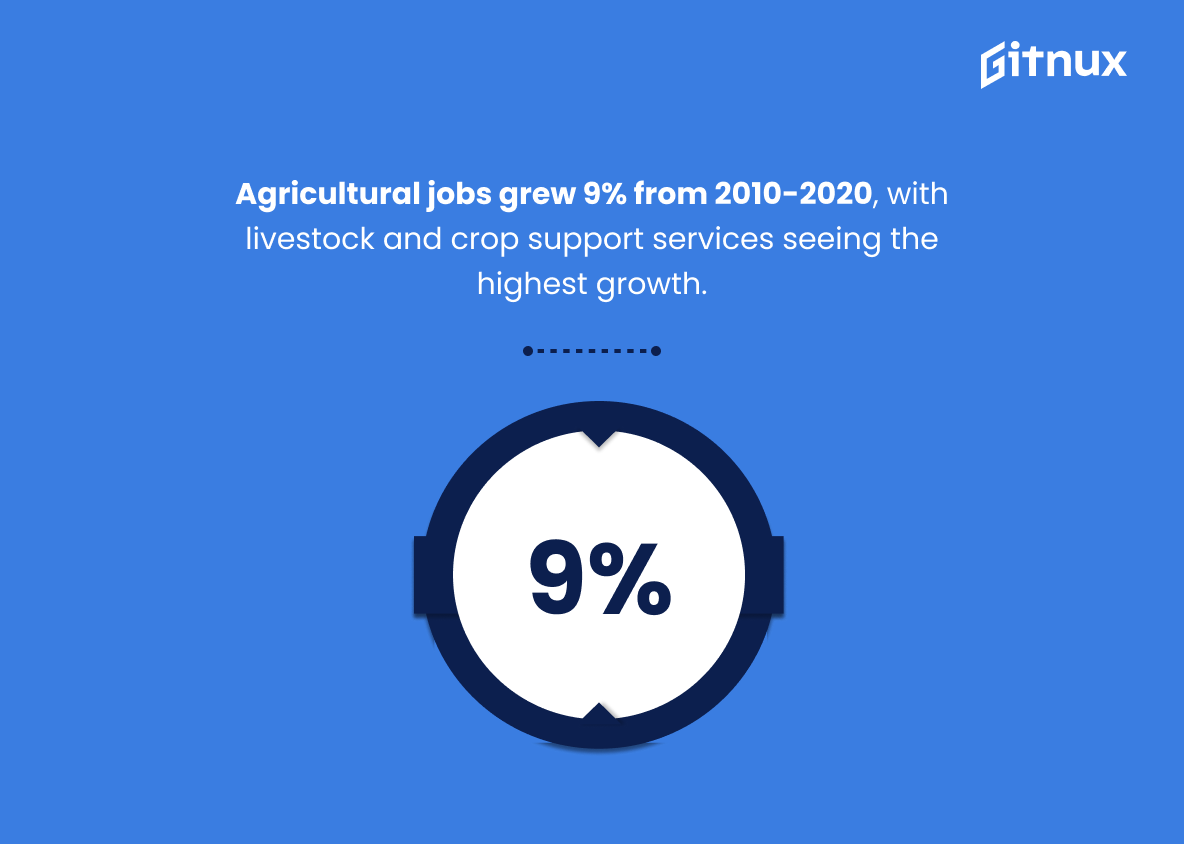The agricultural industry is an important part of the global economy, providing food, fiber, and other resources to people around the world. As such, it is important to understand the current state of the industry and its trends. In this blog post, we will take a look at some of the most recent agricultural industry statistics to gain a better understanding of the industry and its future.
We will look at the size of the industry, its growth rate, and the types of crops and livestock that are most commonly produced. We will also discuss the impact of climate change and other environmental factors on the industry.
Agricultural Industry: The Most Important Statistics
The income earned in South Africa’s agricultural sector increased by 13.1% in 2020, amounting to almost 371 billion South African rand (around 23.62 billion U.S. dollars).
In 2021, 21.1 million full- and part-time jobs were related to the agricultural and food sectors, making up 10.5% of total U.S. employment.
Agricultural Industry Statistics Overview
The United States is a major agricultural producer and supplier, employing 960,000 people across 2 million farms and 89.5 million acres of farmland valued at 2.9 trillion US dollars.
In 2021, US agricultural exports were worth 172 billion US dollars, while imports were worth 163.3 billion US dollars. Thus, the US plays in the global agricultural trade, and the scale of the US agricultural industry.
97% of US farms are family owned, and they have an advantage due to their understanding of local soil and weather conditions, yet they make only $350,000 a year before costs.
This statistic is important because it highlights the competitive advantage that family farms have, yet also shows the economic struggles they face.
South Africa has the largest agricultural land on the African continent, but only contributes 2.4% of GDP and produces a wide variety of crops, with maize and sugar cane being the leading crops.
Although South Africa has a large amount of agricultural land, it is not as productive as other countries, and the agricultural sector is not as important to the economy as other sectors.
South Africa’s agricultural exports exceeded imports in 2020, with horticulture crops leading the exports and cereals and oilseeds leading the imports.
Organic agriculture has been increasing since 2016, but is yet to reach the levels attained in 2009. This provides insight into the current state of the agricultural industry in South Africa, which can be used to inform decisions and strategies related to the industry.
The income earned in South Africa’s agricultural sector increased by 13.1% in 2020, amounting to almost 371 billion South African rand (around 23.62 billion U.S. dollars).
This increase in income is important because it shows that the agricultural industry in South Africa is growing and is a major contributor to the country’s economy. Also, the growth is likely due to the diversity of the sector, which includes corporate and private intensive and extensive crop farming systems.
The agriculture, forestry, and fishing industry in South Africa contributed an added value of nearly 129 billion South African Rand (roughly 8.51 billion U.S. dollars) to the country’s GDP in 2021, an 8.3% increase from 2020.
Therefore, the agriculture industry in South Africa plays a huge role in terms of infrastructure development, decreasing unemployment and contributing to the GDP. The industry is also a huge part of the country’s economy.
The U.S. is a major player in the global trade of agricultural products, with exports of agricultural products worth 172 billion U.S. dollars in 2021 and imports worth 163.3 billion U.S. dollars.
This statistic matters in the context of Agricultural Industry Statistics because it provides insight into the current state of the agricultural industry in the U.S. and the countries/regions with which it trades.
It also shows the growth of the industry over the past few years, with imports increasing from 143.4 billion dollars in 2020 to 163.3 billion dollars in 2021.
The value of U.S. agricultural exports increased in 2021, reaching record levels, with exports valued at $177 billion and imports valued at $171 billion.
The increase shows that the agricultural industry is thriving and growing, which is beneficial for the economy and for consumers who are able to access a wider variety of produce.
In 2021, 21.1 million full- and part-time jobs were related to the agricultural and food sectors, making up 10.5% of total U.S. employment.
This highlights the importance of the food and beverage manufacturing sector, which employed 1.7 million people, or 1.1% of all U.S. nonfarm employment.
The number of jobs in the agricultural industry has grown by 9% from 2010-2020, with the highest growth in the livestock and crop support services sectors.
It also shows that there is a need for more workers in the agricultural industry, which could lead to more job opportunities for people in the sector.
Supplementary Statistics
Agriculture accounts for about 3.1% of the global GDP.
Despite the relatively small size of the sector, it still contributes significantly to the overall GDP of the world. This highlights the need for continued investment in the agricultural industry to ensure its continued growth and success.
Nearly 40% of the global land area is used for agriculture.
It highlights the sheer scale of the agricultural industry and its importance in providing food and other resources to the world. It also serves as a reminder of the need to ensure that agricultural practices are sustainable and that the land is managed responsibly.
In 2020, the agricultural industry’s value in the United States was approximately $388 billion.
This serves as a reminder of the hard work and dedication of the farmers and agricultural workers who make this industry possible.
India had the largest agricultural output in the world in 2018, at about $396.99 billion.
It is a powerful reminder of the importance of the agricultural sector in India, and serves as a reminder of the potential for growth and development in the industry. Furthermore, it serves as a benchmark for other countries to strive for, and provides a valuable insight into the current state of the agricultural industry worldwide.
As of 2020, China is the largest producer of rice, with an annual production of about 211.5 million metric tons.
This highlights the country’s impressive ability to produce a staggering amount of rice each year, demonstrating the strength of its agricultural sector. This statistic is an important reminder of the importance of the agricultural industry in China and its potential to continue to be a major player in the global agricultural market.
In 2021, there are approximately 2.04 billion acres of agricultural land around the world.
Knowing this, also serves as a reminder of the importance of the agricultural industry in providing food and other resources to the world’s population. This statistic is a testament to the hard work and dedication of farmers and agricultural workers around the world.
Agriculture provides jobs to more than 26% of the global working population.
37.5% of global greenhouse gas emissions come from agriculture and the food sector.
This shows the need for more sustainable practices in the sector to reduce the amount of greenhouse gas emissions it produces. It also serves as a call to action for the industry to take responsibility for its role in climate change and to make changes that will help protect the planet.
By 2050, the global food demand is expected to increase by 59-98%.
With the global population expected to increase by 2050, the demand for food will skyrocket, and the agricultural industry will need to find ways to meet this demand. This statistic highlights the need for the agricultural industry to innovate and develop new strategies to ensure that the world’s food supply is able to keep up with the growing population.
The total irrigated land area worldwide was approximately 309.5 million hectares in 2020.
It highlights the sheer amount of land that relies on irrigation to produce crops, demonstrating the need for efficient and sustainable irrigation practices. It also serves as a reminder of the importance of the agricultural industry in providing food and other resources to the world.
In 2019, 37% of EU’s total land area was dedicated to agriculture.
A significant portion of the EU’s land is devoted to agricultural activities, demonstrating the vital role that agriculture plays in the region’s economy and society. This statistic is especially relevant in a blog post about Agricultural Industry Statistics, as it provides a snapshot of the current state of the industry and its importance to the EU.
In 2020, the global agricultural tractor market was valued at approximately $60 billion.
On this, we can see the vital role that agricultural tractors play in the global economy, providing a crucial source of income for farmers and other agricultural workers. This statistic is a powerful reminder of the importance of the agricultural industry and the need to continue to invest in it.
Over 820 million people in the world suffer from undernourishment.
With over 820 million people suffering from undernourishment, it is clear that the industry must take steps to increase food production and distribution in order to ensure that everyone has access to the nutrition they need.
The market for smart agriculture is expected to reach $12.85 billion by 2024.
It is a sign that the industry is on the rise, and that investments in this sector could be highly lucrative. This statistic is a valuable insight for anyone interested in the agricultural industry, and could be a great starting point for further research.
In 2020, the global fertilizers market was valued at $83.5 billion.
Fertilizers are a major component of the agricultural industry, and that the industry is worth billions of dollars. This statistic is a powerful reminder of the significance of the agricultural industry and its impact on the global economy.
Organic agricultural land has increased by 668% between 1999 and 2017.
Organic farming has become increasingly popular, with more and more farmers turning to organic methods to produce their crops. This is an important indicator of the health of the agricultural industry, as it demonstrates that organic farming is becoming a viable option for farmers looking to increase their yields and reduce their environmental impact.
In 2019, women made up approximately 41.7% of the agricultural workforce worldwide.
The agricultural industry is not a male-dominated field, but rather a diverse and inclusive one. This statistic is a testament to the hard work and dedication of women in the agricultural industry, and it should be celebrated.
Around 70% of the global freshwater withdrawal is for agricultural purposes.
This displays the need for sustainable practices and efficient water management in order to ensure that the industry can continue to provide food and other products to the world’s population without depleting our precious freshwater resources.
The use of pesticides worldwide has increased by 81% from 1990 to 2017.
Thus, there is the need for more sustainable and eco-friendly farming practices, as well as the need for greater regulation of the use of pesticides in order to protect the environment and human health.
In 2020, Brazil ranked as the largest producer of coffee, with a production of 3.6 million metric tons.
This highlights the country’s commitment to producing high-quality coffee, and its ability to remain the world’s largest producer despite the challenges posed by the pandemic. It also serves as a reminder of the importance of the agricultural industry in Brazil, and the need for continued investment in the sector to ensure its continued success.
Conclusion
In conclusion, the agricultural industry is an important part of the global economy. It is responsible for providing food and other products to the world.
The industry is constantly changing and evolving, and it is important to stay up to date with the latest statistics and trends in order to make informed decisions. By understanding the current state of the agricultural industry, businesses can make more informed decisions and better prepare for the future.
References
https://www.statista.com/topics/1126/us-agriculture/#topicOverview
https://www.thebalancemoney.com/us-agriculture-stats-facts-history-4776144
https://www.statista.com/topics/9876/agriculture-in-south-africa/#topicOverview
https://www.statista.com/statistics/1310201/income-of-agriculture-and-related-services/#:~:text=In%202020%2C%20the%20total%20income%20in%20the%20agriculture,U.S.%20dollars%29%20were%20generated%20in%20the%20agriculture%20industry.
https://www.statista.com/statistics/1121213/agriculture-value-added-to-gdp-in-south-africa/#:~:text=In%202021%2C%20the%20agriculture%2C%20forestry%2C%20and%20fishing%20industry,dollars%29%20to%20the%20country%27s%20Gross%20Domestic%20Product%20%28GDP%29.
https://www.statista.com/statistics/221737/total-value-of-us-agricultural-imports-since-1990/
https://www.ers.usda.gov/data-products/ag-and-food-statistics-charting-the-essentials/agricultural-trade/
https://www.ers.usda.gov/data-products/ag-and-food-statistics-charting-the-essentials/ag-and-food-sectors-and-the-economy/
https://www.ers.usda.gov/topics/farm-economy/farm-labor
https://www.export.gov
https://www.statista.com
https://ec.europa.eu
https://www.who.int
https://ourworldindata.org
https://www.worldatlas.com
https://data.worldbank.org
https://www.ilo.org
https://www.worldbank.org
https://www.reuters.com
https://www.pnas.org

